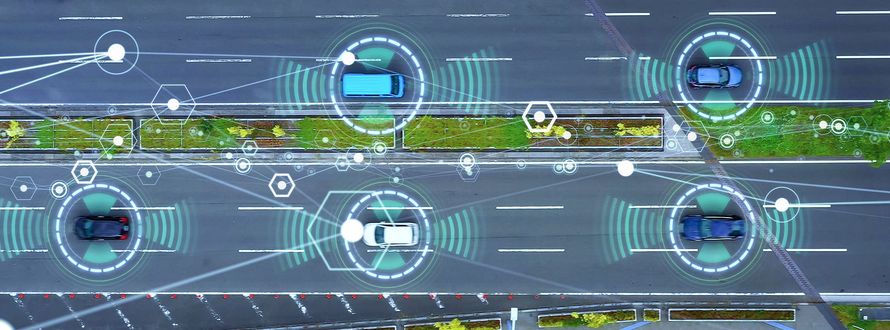
Driving the Future: Mandatory Driver Assistance Systems from 2024
– Automotive, SafetyToday, most vehicles are moving computers, filled with sensors and Electronic Control Units (ECUs): Numerous electronic helpers monitor and control functions through software, protect occupants and other road users, and provide extensive comfort features. Some operate unnoticed in the background, while others require active driver input.
Driver assistance systems (or ADAS, Advanced Drivers Assistance Systems) support the driver and enhance vehicle and passenger safety. There are already many assistants available and they are being further developed for future systems in cars, trucks and buses. Starting mid-2024, some of these systems are mandatory in the European Union for new vehicle registrations.
Braking Assistants
We start our overview with the various brake assistants to achieve maximum deceleration in emergency situations:
Brake Assistant
The brake assistant recognizes the desire for full braking and increases brake pressure for maximum possible deceleration. It evaluates how quickly the accelerator pedal is released and how quickly and forcefully the brake pedal is subsequently pressed. ABS and ESP ensure that the vehicle remains under control.
Many drivers do not press the brake pedal forcefully enough during emergency or full braking; the brake assistant helps in such cases. The brake assistant contributes to reducing the braking distance, preventing accidents, or at least reducing their severity.
Anti-lock Braking System (ABS)
An anti-lock braking system prevents the locking of one or more wheels during braking. The wheel speed is detected by sensors, and when wheel lock is detected, the brake force for that particular wheel is reduced until it rolls instead of skidding. This shortens the braking distance (static friction is higher than sliding friction), and the vehicle maintains its directional stability, remaining controllable.
The ABS significantly contributes to reducing accident numbers, especially in adverse road conditions like wet, leafy, icy, or snowy surfaces. When purchasing older used cars, it is advisable to ensure that ABS is installed.
Other terms would be Antilock Braking System, Automatic Blocker Preventer or Antiskid Device.
Electronic Brake-force Distribution (EBD)
Due to weight distribution in the vehicle and weight transfer during cornering and braking maneuvers, individual brake forces per axle or wheel are crucial for optimal braking performance and deceleration. While ABS and ESP react only when slip is detected, electronic brake-force distribution modulates brake pressure to prevent slip from occurring in the first place.
Electronic brake-force distribution replaces previously common mechanical solutions, where braking caused unloading of the rear axle, and brake pressure for the rear axle was accordingly reduced. Since mechanical elements in the suspension are susceptible to dirt and corrosion, electronic solutions are safer and more precise.
Collision Warning System
The collision warning system detects situations where only an immediate full brake, including the driver's reaction time, can prevent an accident or at least mitigate the impact. It alerts the driver through a clear acoustic and visual warning to brake immediately and avoid a collision. The collision warning system is usually integrated into the emergency braking assistant and activates as a warning cascade just before the autonomous emergency braking assistant initiates braking. It is also useful in turning maneuvers of trucks, as it can detect cyclists and pedestrians in the blind spot of the mirrors and warn the driver accordingly.
The collision warning system not only supports when the driver is inattentive but also covers situations that may overwhelm the driver, such as merging with simultaneous backward and forward views or other confusing traffic situations. Today, it plays a subordinate role due to the autonomous emergency braking assistant; automatic emergency braking is more effective due to faster response. As a distance warning, it informs the driver about falling below the safety distance, making a valuable contribution to road safety, as the driver must always be able to brake in time.
Other terms would be Distance Warning, Collision Warning, pre sense, Predictive Safety System, Pre-Safe Brake, Front Assist, Collision Mitigation System or Forward Collision Warning.
Turning Assistant / Blind Spot Information System
Exterior mirrors cannot cover all viewing angles, especially in larger vehicles like trucks and buses. Sensors in the mirrors and/or at the corners of the vehicle monitor areas to the right of the vehicle. The assistance system warns the driver if an unprotected road user (pedestrian, cyclist) is present, and depending on the configuration, initiates braking if the driver does not react.
The mandatory introduction of turning assistants for trucks and buses is an important step, as cyclists or pedestrians are regularly severely or fatally injured because they are in the blind spot of a truck and are overlooked by the driver. There is a particular danger at intersections where the view to the side and rear is significantly limited in a truck. Numerous mirrors are supposed to compensate for this; however, a blind spot remains, which the driver cannot or only partially see. Here assistants can help to reduce dangerous situations tremendously with support of outside sensors and cameras to scan the environment around the vehicle.
Automatic Emergency Braking System (AEB)
The emergency braking system recognizes situations where only an immediate full brake can prevent an accident or at least mitigate the impact. It only reacts automatically when the driver does not respond to the warning cascade or cannot prevent an accident with their reaction time. The detection spectrum expands with the progress of technical development. Initially, it only mitigated rear-end collisions in city traffic, but powerful AEB systems can now prevent accidents at highway speeds.
Nowadays, scenarios involving turns and intersections are included, and the detection and response to unprotected road users such as pedestrians, cyclists, and motorized two-wheelers are part of today's emergency braking system. It should also detect people and children behind the vehicle during reverse driving, as well as crossing cyclists and cars.
The emergency braking assistant is one of the most important and efficient of the newer assistance systems to increase road safety and reduce the number of accidents with serious injuries or fatalities. It supports not only when the driver is inattentive but also covers situations that may overwhelm the driver, such as merging with simultaneous backward and forward views, confusing traffic situations, or darkness with poorly visible, unprotected road users. Equipping vehicles with emergency braking systems is essential to reduce traffic accidents and thus the consequences of accidents.
Other terms would be Autonomous Emergency Braking Assistant, Emergency Braking System, Autonomous Emergency Breaking System, City Brake, Front Assist, Active City Stop, Collision Prevention Assist, Collision Mitigation Brake System, Auto-Brake with Forward Collision Warning, Collision Avoidance Assist or Advanced Emergency Braking System.
Evasive Assistant
The evasive assistant helps the driver to avoid an obstacle when full braking is not sufficient to prevent a collision. If the system detects a steering movement indicating that the driver wants to evade, it supports the steering movement to ensure that the vehicle does not collide with the obstacle ahead. There is sometimes a slight steering back after evading. The following traffic and oncoming traffic are not monitored. The evasive assistant only works in combination with the emergency braking assistant and does not initiate evasion independently.
Empowering the Assistant: How is SYSGO involved?
SYSGO is specialized in providing Real-Time Operating Systems (RTOS) and embedded software solutions, particularly for safety and security-critical applications. While the detailed functionalities and features of SYSGO's products are not explicitly outlined in the provided text, I can provide a general overview of how a company like SYSGO could support the development and implementation of driver assistance systems.
Real-Time Operating System (RTOS): SYSGO offers real-time operating systems that are optimized for embedded systems. An RTOS is crucial for applications where timing and response are critical, such as in driver assistance systems.
Hypervisor Technology: SYSGO offers hypervisor technology, allowing for the virtualization of hardware resources. This is particularly useful in the automotive industry, where different functions (such as infotainment and driver assistance) often run on the same hardware platform. A hypervisor can help ensure the isolation of critical functions.
Functional Safety Certification: Many driver assistance systems fall under the category of safety-critical systems. SYSGO provides RTOS that are certified according to safety standards like ISO 26262 for Automotive. This certification ensures that the software meets specific safety requirements.
Integration of Middleware: Our products include middleware solutions that facilitate the integration of various components within the driver assistance system. Middleware can help manage communication between sensors, control units, and the central processing unit.
Security Features: Given the increasing connectivity of vehicles, security is a paramount concern. SYSGO's products incorporate security features to protect against cyber threats and unauthorized access to the driver assistance system.
Customization and Adaptability: Our solutions offer flexibility and adaptability to meet the specific requirements of different automotive manufacturers and their varied driver assistance systems.
Compliance with Automotive Standards: The products from SYSGO comply with automotive industry standards and regulations, ensuring that the developed systems meet the required safety and performance criteria.
SACoP - Secure Automotive Connectivity Platform
SACoP is our high-performance base system for Automotive & Transportation communication that supports several networks, such as 4G/5G, WI-FI, Ethernet & CAN, and provides firewall, intrusion detection system & software life cycle management. It also offers optional guest operating systems, such as Android, Linux or AGL, and protection of critical vehicle-internal communication.
More information at www.sysgo.com/sacop
---
More information at www.sysgo.com/pikeos
More information at www.sysgo.com/elinos
-
Previous
-
Next

 Twitter
Twitter LinkedIn
LinkedIn Facebook
Facebook Reddit
Reddit RSS
RSS Copy link
Copy link
